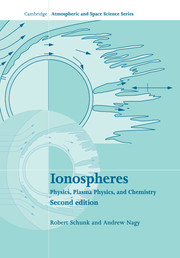Book contents
- Frontmatter
- Contents
- Chapter 1 Introduction
- Chapter 2 Space environment
- Chapter 3 Transport equations
- Chapter 4 Collisions
- Chapter 5 Simplified transport equations
- Chapter 6 Wave phenomena
- Chapter 7 Magnetohydrodynamic formulation
- Chapter 8 Chemical processes
- Chapter 9 Ionization and energy exchange processes
- Chapter 10 Neutral atmospheres
- Chapter 11 The terrestrial ionosphere at middle and low latitudes
- Chapter 12 The terrestrial ionosphere at high latitudes
- Chapter 13 Planetary ionospheres
- Chapter 14 Ionospheric measurement techniques
- Appendix A Physical constants and conversions
- Appendix B Vector relations and operators
- Appendix C Integrals and transformations
- Appendix D Functions and series expansions
- Appendix E Systems of units
- Appendix F Maxwell transfer equations
- Appendix G Collision models
- Appendix H Maxwell velocity distribution
- Appendix I Semilinear expressions for transport coefficients
- Appendix J Solar fluxes and relevant cross sections
- Appendix K Atmospheric models
- Appendix L Scalars, vectors, dyadics, and tensors
- Appendix M Radio wave spectrum
- Appendix N Simple derivation of continuity equation
- Appendix O Numerical solution for F region ionization
- Appendix P Monte Carlo methods
- Index
Chapter 2 - Space environment
Published online by Cambridge University Press: 22 January 2010
- Frontmatter
- Contents
- Chapter 1 Introduction
- Chapter 2 Space environment
- Chapter 3 Transport equations
- Chapter 4 Collisions
- Chapter 5 Simplified transport equations
- Chapter 6 Wave phenomena
- Chapter 7 Magnetohydrodynamic formulation
- Chapter 8 Chemical processes
- Chapter 9 Ionization and energy exchange processes
- Chapter 10 Neutral atmospheres
- Chapter 11 The terrestrial ionosphere at middle and low latitudes
- Chapter 12 The terrestrial ionosphere at high latitudes
- Chapter 13 Planetary ionospheres
- Chapter 14 Ionospheric measurement techniques
- Appendix A Physical constants and conversions
- Appendix B Vector relations and operators
- Appendix C Integrals and transformations
- Appendix D Functions and series expansions
- Appendix E Systems of units
- Appendix F Maxwell transfer equations
- Appendix G Collision models
- Appendix H Maxwell velocity distribution
- Appendix I Semilinear expressions for transport coefficients
- Appendix J Solar fluxes and relevant cross sections
- Appendix K Atmospheric models
- Appendix L Scalars, vectors, dyadics, and tensors
- Appendix M Radio wave spectrum
- Appendix N Simple derivation of continuity equation
- Appendix O Numerical solution for F region ionization
- Appendix P Monte Carlo methods
- Index
Summary
Before discussing the various ionospheres in detail, it is necessary to describe the physical characteristics of the bodies in the solar system that possess ionospheres as well as the plasma and electric–magnetic environments that surround the bodies because they determine the dynamical processes acting within and on the ionospheres. It is also useful to give a brief overview of the characteristics of the different ionospheres, including those associated with planets, moons, and comets. This not only allows the reader to see easily the diversity of ionospheric characteristics and features, but also provides motivation for the fundamental physics and chemistry covered in later chapters. In what follows, the sequence of the discussion is the Sun, the interplanetary medium, the Earth, the inner and outer planets, and then moons and comets.
Sun
The Sun is a star of average mass (1.99 × 1030 kg), radius (6.96 × 105 km), and luminosity (3.9 × 1026 watts) whose remarkable steady output of radiation over several billion years has allowed life to develop on Earth. The Sun is composed primarily of hydrogen and helium, with small amounts of argon, calcium, carbon, iron, magnesium, neon, nickel, nitrogen, oxygen, silicon, and sulfur. The solar energy is generated from the nuclear fusion of hydrogen into helium in a very hot central core, which is about 16 million kelvins. This energy is first transmitted through the radiative zone and then the convective zone, which is the outer 2.00 × 105 km of the Sun. The Sun's surface is irregular because of the strong convection in this outer zone, displaying both small-scale and large-scale convective cells or granules. The small-scale cells are about 1000 km in diameter, with individual cells lasting for approximately 10 minutes.
- Type
- Chapter
- Information
- IonospheresPhysics, Plasma Physics, and Chemistry, pp. 11 - 49Publisher: Cambridge University PressPrint publication year: 2009



